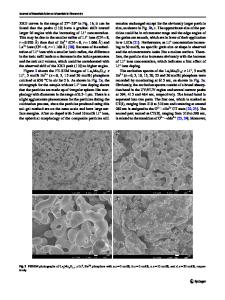Eu +3 and Cr +3 doping for red cathodoluminescence in ZnGa 2 O 4
- PDF / 122,243 Bytes
- 5 Pages / 612 x 792 pts (letter) Page_size
- 52 Downloads / 371 Views
Jeffrey J. Peterson and Michael D. Potter Advanced Vision Technologies, Inc, 150 Lucius Gordon Drive, Suite 215, West Henrietta, New York 14586
Wounjhang Park Georgia Tech Research Institute, Atlanta, Georgia 30332 (Received 25 October 2000; accepted 26 February 2001)
Cathodoluminescence emission spectra and photoluminescence (PL) excitation spectra were used to evaluate Eu+3 and Cr+3 as activators for red luminescence in ZnGa2O4. In the ZnGa2O4:Eu materials red emission from Eu+3 and blue intrinsic emission were observed. The blue intrinsic emission increased relative the Eu+3 emission with increasing current density and is attributed to preferential current saturation of the Eu+3 activators. In addition, PL excitation measurements revealed that the inefficient energy transfer from the ZnGa2O4 host to the Eu+3 is due to poor spectral overlap between the ZnGa2O4 emission and the Eu+3 absorption. Cr-doping resulted in a saturated red-color, and no host emission was observed over the entire current density regime investigated. The PL excitation of the ZnGa2O4:Cr revealed good overlap between the ZnGa2O4 host and the Cr+3 absorption. Efficient energy transfer to the Cr+3 activators occurs via multipolar interactions.
I. INTRODUCTION
Flat panel display technologies such as field emission displays (FEDs) and vacuum fluorescent displays (VFDs) have rekindled a significant interest in lowvoltage cathodoluminescent materials. While many efficient sulfide-based phosphors have been explored as possible low-voltage phosphors, the volatility of sulfur has prohibited their use in FEDs or VFDs. There are basically two deleterious effects that sulfide-based phosphors have on these devices. First, electron-stimulated reactions have been shown to form a sulfur-deficient nonluminescent layer on the phosphor surface, which reduces the phosphor efficiency.1 Second, the electronstimulated reaction by-products are known to poison electron emitters. One of the most widely studied low-voltage cathodoluminescent (CL) phosphors is ZnGa 2 O 4 . Because ZnGa2O4 is an oxide-based phosphor, many of the degradation problems associated with sulfide-based phosphors are obviated. In addition, ZnGa2O4 also has a reasonable conductivity which prohibits phosphor charging at low voltages. ZnGa2O4 is a normal spinel [space group is Fd3m (O7h)] in which the Zn+2 ions occupy the A sites and are tetrahedrally coordinated, and the Ga+3 J. Mater. Res., Vol. 16, No. 5, May 2001
http://journals.cambridge.org
Downloaded: 16 Mar 2015
ions occupy the B sites and are octahedrally coordinated. ZnGa2O4 is an intrinsic blue emitter, with a peak wavelength of approximately 450 nm depending on the zinc to gallium ratio.2 The blue emission is saturated blue in color [Commission Internationale de l’Eclairage (CIE) coordinates: x ⳱ 0.170 and y ⳱ 0.130] and CL efficiencies as high as 0.7 lm/W at 30V direct current (dc) have been reported.3 For Mn+2-doped ZnGa2O4 materials, Mn+2 substitutes for Zn+2 sites and results in a saturated green emission (peak wavelength app
Data Loading...











